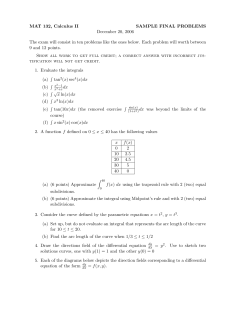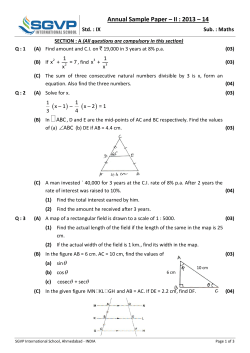
Sample Questions (Chapter 3, Math 244)
Sample Questions (Chapter 3, Math 244) 1. State the Existence and Uniqueness theorem for linear, second order differential equations (non-homogeneous is the most general form): 2. True or False? (a) The characteristic equation for y 00 + y 0 + y = 1 is r2 + r + 1 = 1 (b) The characteristic equation for y 00 + xy 0 + ex y = 0 is r2 + xr + ex = 0 (c) The function y = 0 is always a solution to a second order linear homogeneous differential equation. (d) In using the Method of Undetermined Coefficients, the ansatz yp = (Ax2 + Bx + C)(D sin(x) + E cos(x)) is equivalent to yp = (Ax2 + Bx + C) sin(x) + (Dx2 + Ex + F ) cos(x) 3. Find values of a for which any solution to: y 00 + 10y 0 + ay = 0 will tend to zero (that is, limt→0 y(t) = 0. 4. • Compute the Wronskian between f (x) = cos(x) and g(x) = 1. • Can these be two solutions to a second order linear homogeneous differential equation? Be specific. (Hint: Abel’s Theorem) 5. Construct the operator associated with the differential equation: y 0 = y 2 − 4. Is the operator linear? Show that your answer is true by using the definition of a linear operator. 6. Find the solution to the initial value problem: 3t u + u = 3(2π − t) 0 00 7. Solve: u00 + ω02 u = F0 cos(ωt), Undetermined Coefficients. if 0 ≤ t ≤ π if π < t < 2π if t ≥ 2π u(0) = 0 u0 (0) = 0 u(0) = 0 u0 (0) = 0 if ω 6= ω0 using the Method of 8. Compute the solution to: u00 + ω02 u = F0 cos(ω0 t) u(0) = 0 u0 (0) = 0 two ways: • Start over, with Method of Undetermined Coefficients • Take the limit of your answer from Question 6 as ω → ω0 . 9. For the following question, recall that the acceleration due to gravity is 32 ft/sec2 . An 8 pound weight is attached to a spring from the ceiling. When the weight comes to rest at equilibrium, the spring has been stretched 2 feet. The damping constant for the system is 1−lb-sec/ft. If the weight is raised 6 inches above equilibrium and given an upward velocity of 1 ft/sec, find the equation of motion for the weight. Write the solution as R cos(ωt − δ), if possible. 10. Given that y1 = 1 t solves the differential equation: t2 y 00 − 2y = 0 Find a fundamental set of solutions. 11. Suppose a mass of 0.01 kg is suspended from a spring, and the damping factor is γ = 0.05. If there is no external forcing, then what would the spring constant have to be in order for the system to critically damped? underdamped? 12. Give the full solution, using any method(s). If there is an initial condition, solve the initial value problem. (a) y 00 + 4y 0 + 4y = t−2 e−2t (b) y 00 − 2y 0 + y = tet + 4, y(0) = 1, y 0 (0) = 1. (c) y 00 + 4y = 3 sin(2t), y(0) = 2, y 0 (0) = −1. 00 (d) y + 9y = N X bm cos(mπt) m=1 13. Rewrite the expression in the form a + ib: (i) 2i−1 (ii) e(3−2i)t (iii) eiπ √ √ 14. Write a + ib in polar form: (i) −1 − 3i (ii) 3i (iii) −4 (iv) 3 − i 15. Find a second order linear differential equation with constant coefficients whose general solution is given by: 1 y(t) = C1 + C2 e−t + t2 − t 2 16. Determine the longest interval for which the IVP is certain to have a unique solution (Do not solve the IVP): t(t − 4)y 00 + 3ty 0 + 4y = 2 y(3) = 0 y 0 (3) = −1 17. Let L(y) = ay 00 + by 0 + cy for some value(s) of a, b, c. If L(3e2t ) = −9e2t and L(t2 + 3t) = 5t2 + 3t − 16, what is the particular solution to: L(y) = −10t2 − 6t + 32 + e2t 18. If we take the ansatz y = tr , find a fundamental set of solutions for t2 y 00 + 2ty 0 − 2y = 0 19. If x = ln(t) and y˙ = dy/dt, then verify that dy = t y˙ dx d2 y = t2 y¨ + ty˙ dx2 and 20. Use Variation of Parameters to find a particular solution to the following, then verify your answer using the Method of Undetermined Coefficients: 4y 00 − 4y 0 + y = 16et/2 21. Compute the Wronskian of two solutions of the given DE without solving it: x2 y 00 + xy 0 + (x2 − α2 )y = 0 22. If y 00 − y 0 − 6y = 0, with y(0) = 1 and y 0 (0) = α, determine the value(s) of α so that the solution tends to zero as t → ∞. 23. Show that the period q of motion of an undamped vibration of a mass hanging from a vertical spring is 2π L/g, where L is the elongation of the spring due to the mass and g is the acceleration due to gravity. 24. Give the general solution to y 00 + y = 1 sin(t) +t 25. A mass of 0.5 kg stretches a spring to 0.05 meters. (i) Find the spring constant. (ii) Does a stiff spring have a large spring constant or a small spring constant (explain). 26. A mass of 12 kg is attached to a spring with spring constant 2 (kg/sec2 ). The spring is pulled down an additional 1 meter then released. Find the equation of motion if the damping constant is c = 2 as well: 27. Match the solution curve to its IVP (There is one DE with no graph, and one graph with no DE- You should not try to completely solve each DE). (a) 5y 00 + y 0 + 5y = 0, y(0) = 10, y 0 (0) = 0 (b) y 00 + 5y 0 + y = 0, y(0) = 10, y 0 (0) = 0 (c) y 00 + y 0 + 54 y = 0, y(0) = 10, y 0 (0) = 0 (d) 5y 00 + 5y = 4 cos(t), y(0) = 0, y 0 (0) = 0 (e) y 00 + 21 y 0 + 2y = 10, y(0) = 0, y 0 (0) = 0
© Copyright 2025





















